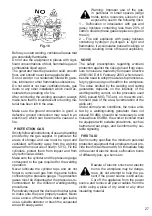
25
Any symptom of discomfort or pain in the
eyes, nose or throat may be caused by ina
-
dequate ventilation; if this is the case, imme
-
diately interrupt work and ventilate the area.
Do not weld metals or painted metals contai-
ning zinc, lead, cadmium or beryllium, unless
the operator and the persons nearby are
using breathing apparatuses or wearing hel
-
mets with oxygen cylinder.
Should welding operations be carried out in
conditions different from the usual working
conditions, with an increased risk of electric
shock (reduced or damp working area), ad
-
ditional precautions must be taken, such as:
- Using power generators marked “S”;
- Placing the power generator out of the wor
-
king area;
- Reinforcing personal protection devices,
ground insulation and insulation between the
piece to be welded and the operator (Fig. 7).
que screens, self-extinguishable and in ac
-
cordance with regulation EN 1598 (the color
of the screen will depend on the welding pro
-
cess and on the value of the currents used),
anti-UV goggles and, if necessary, masks
with suitable protection filter (Fig. 4).
Prior to any welding operation, clear the wor
-
king area from all chlorine solvents, which are
normally used to clean or degrease the wor
-
king material. The fumes of these solvents,
when submitted to the radiations of an electric
arc, even from afar, may, in some cases, tran
-
sform into toxic gases. Make sure all the pie
-
ces which are to be welded are absolutely dry.
Warning: When the welding operator
is in a closed space, the use of chlori
-
ne solvents is absolutely forbidden in
the presence of electric arcs.
During the grinding, brushing and hamme
-
ring operations involving the welded pieces,
always wear protection goggles with transpa
-
rent lens to prevent projected chips and any
other foreign particles from hurting your eyes
(Fig. 5).
Unhealthy or dangerous gases or fumes must
be collected (as they are produced) as clo
-
se and efficiently as possible to the source
of emission, in such a manner that the con
-
centration of pollutants does not exceed the
permitted limits (Fig. 6). In addition, all wel
-
ding operations must be carried out on metal
surfaces devoid of rust and paint, to avoid the
formation of hazardous fumes.
Fig.4
Fig.5
Fig.6
Fig.7
Содержание Compact 220 AC/DC
Страница 2: ...2 IT GB FR ES PAGINA 6 PAGE 22 PAGE 38 PÁGINA 54 D SEITE 70 P PÁGINA 86 ...
Страница 104: ...104 EXPLODED VIEW ...
Страница 106: ...106 WIRING DIAGRAM ...
Страница 107: ...107 ...
Страница 108: ...77611454 11 2017 ...
















































